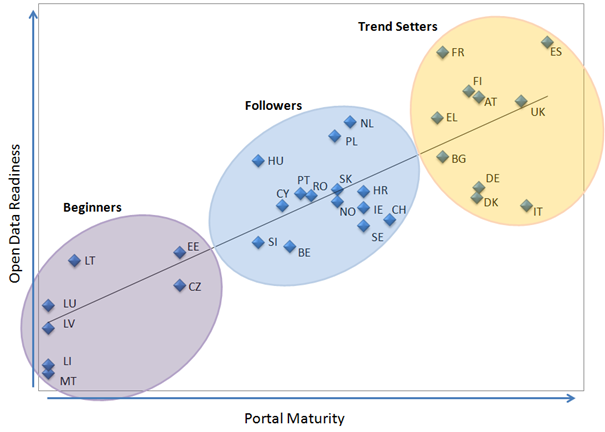Open Data Maturity in Europe
Where do the European countries stand with regard to the deployment of Open Data?
Where do the 28 European countries plus Liechtenstein, Norway and Switzerland (EU28+) stand with regard to the deployment of Open Data? An overview of the most important findings of the Open Data Maturity Assessment, including Open Data Readiness and Portal Maturity.
Where do European countries stand with regard to Open Data? What key policies have been set up? What are the key features of national data portals?
To measure Open Data Maturity two key indicators have been selected. These indicators cover both the maturity of national policies promoting Open Data as well as an assessment of the features made available on national data portals
Open Data Readiness is focused on policies, licensing norms, coordination at the national level, use and impact.
The Open Data Readiness indicator shows an EU28+ average of 44.7%. In total, 27 countries have a national Open Data portal, leaving 4 countries without a portal. An Open Data Policy is in place in 71% of the countries often as part of a more generic Digital Strategy or eGovernment programme. More than 8 events are held in 35% of the countries. The field with the most room for improvement is national coordination.
Portal Maturity consists of usability of the portal, re-usability of data and spread across domains.
The Portal Maturity indicator shows an EU28+ average of 40.8%. There is a huge difference between features on the national portals. Only 33% of the portals offer a feedback mechanism. Furthermore, the availability of machine-readable data is relatively low. 15% of the countries have more than 75% of their data available in machine-readable format. The top data domain indicated by the countries was 'Statistics'. However, only 17 countries were able to provide portal statistics.
Based on these results, the EU28+ are clustered into three different levels of Open Data Maturity:
Beginners: the initial steps have been made, but countries still struggle with basics around availability and accessibility. Portal functionalities remain limited and there is a limited coverage in terms of datasets.
Followers: the basics are set, including a clear vision and there are advanced features on the portal. However, the approach to the release of data is very much in silo and remains limited.
Leaders - Trend Setters: these are the most advanced and have solid Open Data portals with elaborate functionalities and coordination mechanisms across domains.

As the picture shows, most countries are now in the 'Followers' group and on their way to becoming 'Trend Setters'.
To move forward with Open Data, a series of recommendations have been made.
- Defining an Open Data strategy as the most solid basis for cooperation across public administrations and engaging more with potential re-users
- Adding basic functionalities on a portal to increase user friendliness and stimulate re-use
- Increasing awareness among citizens and businesses around Open Data
- Offering trainings to civil servants to increase understanding of Open Data
- Developing national guidelines addressing priority domains and frequency of data release to support local initiatives
- Measuring the success of an Open Data initiative can help identify benefits and room for improvement
This landscaping will serve as the knowledge base to help build a European leaders' network of experts and to dive deeper into national activities, to understand where to provide common support activities, and where to offer further specialised training and coaching assistance. Revisions of this study are planned for 2016 and 2017.
To read the full insight report:
Please feel welcome to share your story and help us improve.
